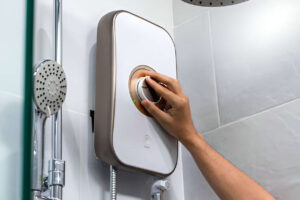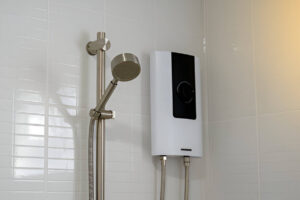Electric Geyser Tips: Safe Use & Setup Guide 2025
An electric geyser is a valuable home appliance that makes sure there is always hot water. You can stay safe and save a lot of money on your energy bills if you know how to use and put your heater in a safe place. This is true whether you use it to wash your dishes in the winter or to take a shower in the morning.
This book includes tips from experts on how to set up an electric geyser, safety rules, ways to save energy, and basic repairs for 2025.
Why Choose an Electric Geyser in 2025?
Even in the year 2025, electric geysers continue to be a favorite. As a result, instant geysers are gaining popularity. They save energy and provide hot water quickly:
- With new thermostat-controlled units, you can get instant heat.
- Small enough to fit in flats and tiny homes
- Auto-cutoff and anti-corrosion technology are two examples of advanced safety features.
Energy.gov says that electric water heaters can be made to use less energy by having options that can be programmed.

Key Components of an Electric Geyser
Know these about your electric heater’s main parts before you put it together or fix it:
- Thermostat – sets the temperature of the Geyser Parts
- Heating element – in charge of heating water
- Pressure release valve – Keeps pressure from building up
- Tank – stores hot water
- Outer casing – guards and insulates the system inside
Safe Setup Guide for Your Electric Geyser
1. Choose the Right Location
- Install in a well-ventilated space
- Stay away from places where water might splash or get wet.
- Keep it at a minimum height of 6 feet for optimal water flow.
2. Get Professional Installation
To do the work, hire a qualified technician to:
- Ensure proper earthing and wiring
- Choose wires and switches with the ISI mark.
- Confirm compliance with local electrical safety codes.
Reference: National Electrical Code
3. Set the Ideal Temperature
- Recommended temperature: 50°C to 60°C
- To avoid burning, don’t set it above 65°C.
- Use temperature regulators for advanced models.
4. Test the Pressure Valve
- Once a month, release the pressure by hand.
- Change it out if there are rust or leaky spots.

Safety Tips for Daily Use
1. Never Keep the Geyser On Unattended
Extended use can:
- Your power bill will go up.
- Overheat the device, which can hurt it from the inside.
2. Regularly Check for Leaks
- Inspect all pipes and joints
- A leaking electric water heater could indicate internal rust or valve failure
3. Switch Off When Not in Use
- Especially when there are long breaks
- To set things to happen automatically, use a bright switch.
4. Avoid Dry Heating
- Before turning it on, make sure the tank has water in it.
- Heat that is not wet can damage the heating device.
Energy-Saving Tips for 2025
- Insulate the water tank to reduce heat loss
- Install low-flow showerheads to minimize hot water usage
- Use solar-assisted electric geysers for hybrid savings
- Upgrade to energy star-rated geysers
As per Energy Star, energy-efficient heaters can reduce utility bills by up to 30% annually.
Troubleshooting Common Electric Geyser Issues
| Problem | Possible Cause | Solution |
| Water not heating | Faulty thermostat or element | Replace faulty part |
| No power supply | Tripped circuit or wiring | Check breaker, call electrician |
| Water leakage | Rusty tank or valve failure | Replace tank or tighten fittings |
| Unusual noises | Sediment buildup | Flush the tank regularly |
Innovative Features to Look for in 2025
If you’re planning to buy or upgrade, consider these features:
- WiFi-enabled geysers for remote control
- Smart timers for scheduled heating
- Anti-scale coating for stiff water resistance
- LED indicators for system status
Comparison with Other Heating Solutions
| Feature | Electric Geyser | Gas Geyser | Solar Heater |
| Cost | Moderate | Low | High upfront |
| Maintenance | Low | Medium | Low |
| Eco-Friendliness | Moderate | Low | High |
| Heating Speed | Fast | Fast | Moderate |
| Safety | High | Moderate | High |
Final Thoughts
The right way to install and use an electric geyser will not only give you hot water, but it will also protect your house and save you money on energy costs. Your service will always be on if you follow the steps and tips in this 2025 guide. You’ll also save money on power and not have to pay for fixes.
Electric Geyser FAQs – 2025 Guide
The electric geyser: how does it work?
Electric geysers heat water using an electric heating element. For efficiency and safety, it usually has a thermostat, insulated tank, and safety valve.
Electric geysers use how much power?
A basic electric geyser uses 1.5 to 3 kWh per hour, depending on power and water demand. Using a thermostat and turning it off when not in use may save electricity.
Are electric geysers safe to leave on 24/7?
Not recommended. Constantly running an electric geyser may cause overheating, component wear, and increased power costs. For energy efficiency, please turn it off after usage or use a timer or smart plug.
What temperature should my electric geyser be?
Electric geysers should be between 50°C and 60°C. This prevents scorching, heat efficiently, and saves energy.
How long does an electric geyser heat water?
A 15–25 liter electric geyser heats water in 10–20 minutes, depending on capacity. Modern types may heat water quicker with increased watts or immediate functionality.